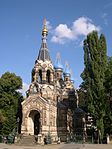Leibniz-Institut für Festkörper- und Werkstoffforschung
Education in DresdenFoundations based in GermanyLeibniz AssociationPhysics institutesScience and technology in East Germany

The Leibniz Institute for Solid State and Materials Research in Dresden (German: Leibniz-Institut für Festkörper- und Werkstoffforschung Dresden) – in short IFW Dresden – is a non-university research institute and a member of the Gottfried Wilhelm Leibniz Scientific Community. It is concerned with modern materials science and combines explorative research in physics, chemistry and materials science with technological development of new materials and products.
Excerpt from the Wikipedia article Leibniz-Institut für Festkörper- und Werkstoffforschung (License: CC BY-SA 3.0, Authors, Images).Leibniz-Institut für Festkörper- und Werkstoffforschung
Hallwachsstraße, Dresden Räcknitz (Plauen)
Geographical coordinates (GPS) Address Website Nearby Places Show on map
Geographical coordinates (GPS)
| Latitude | Longitude |
|---|---|
| N 51.0261 ° | E 13.7244 ° |
Address
Leibniz-Institut für Festkörper- und Werkstoffforschung Dresden
Hallwachsstraße 20
01069 Dresden, Räcknitz (Plauen)
Saxony, Germany
Open on Google Maps







